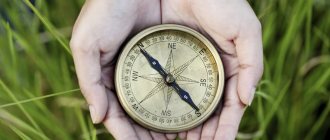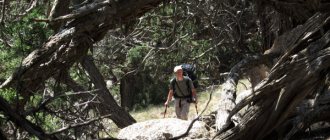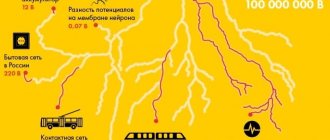Where can I meet you?
Wild boar lives in almost all countries. Of course, in big cities you definitely won’t find one with a cart at the supermarket checkout. But in the suburbs - yes. Without a cart, of course.
Dense forests, valleys near ponds and swamps - in such places there is poor visibility, but the wild boar feels at home.
Males prefer an independent lifestyle, while females with cubs stay in packs. Males join them only during the breeding season.
- The boar is cornered and feels threatened. Self-defense;
- During the breeding season, from November to January, males are very irritable and aggressive, and fight among themselves. It’s better not to catch their eye;
- Like all mothers, female boars will fight to the last to protect their cub. The brood period for wild boars is in the spring;
- Boars, like people, are also not in the mood. You might make him angry.
How to fight a boar?
- Keep calm. Yes, it’s easy to say, but still. Slowly move away from the animal.
- Don't scream or call for help - wild boars are very irritable. Like us in the morning after the party.
- Don't try to feed it, it's not a squirrel.
- Don't scare him or drive him into a corner by trying to take a photo.
- If you see a female boar with her young pigs, completely rule out the idea of babying and taking photographs. We remind you that females protect their cubs.
- Don't try to run away, wild boars run too fast. It's better to wait until he accelerates and jump to the side to confuse him and gain time. Animals are slow and have a long braking distance, so it will work.
- Remember that “taking down a wild boar” is quite a painstaking job; it is one of those species of animals that fight to the last. This is possible if you have a firearm, a serious one at that, and you know where to shoot. Maybe you're hunting. Experienced hunters, when attacked by a wild boar, advise letting it get closer and shooting at places that can stop it: either in the spine or in the head. During an attack, the boar lowers its head as it prepares to strike with its tusks. And it becomes an excellent target. Contrary to popular belief, bullets will not bounce off a boar's forehead.
- When it is already clear that the boar is going to attack, climb somewhere higher: it could be the hood of a car, a boulder, a rock. Boars are not strong at jumping. If you decide to climb a tree, make sure that the wild boar is at a decent distance and you will have time to do it. Boars are fast.
- There is no need to shout at the animal from the top and throw everything that comes to hand. Just wait until he gets bored and goes off to dig holes.
From the book “Survival in the wild and extreme situations using the methods of special services. 100 Key Skills"
The governor of the Irkutsk region taught his grandchildren to kill a wild boar in a cage: what is known about this
Irkutsk Governor Sergei Levchenko invited his grandchildren to “shoot” a wild boar sitting in a cage, and one of the boys agreed to do it. The killing of a defenseless animal occurred during a scandalous bear hunt in January 2017 - then Levchenko was accused of brutally killing an animal sleeping in a den. Recently, new footage of the winter adventures of the governor and his entourage appeared online, and this became the reason for initiating a criminal case.
In September 2020, the IrCity publication published a video of a hunt with the participation of the governor of the Irkutsk region, State Duma deputy from the Communist Party of the Russian Federation Sergei Levchenko: a group of men surrounded a bear sleeping in a den, and the official fired several shots at point-blank range. The video caused a wide public outcry, but the press service of the regional leader called it a provocation before the local elections. Winter hunting for a sleeping bear is prohibited in Russia; later the hero of the scandal explained that the hunt was legal - the killed bear was a connecting rod, wandering through the forest and annoying local residents. And hunting dogs drove him into the den. On top of that, he hunted in November 2016, on the dates when shooting a bear is legal. The investigation found no violations then.
The author of the video depicting the killing of a bear turned out to be Irkutsk blogger Artyom Pavlechko. He accompanied the governor and his retinue during the hunt. On December 20, 2020, on his YouTube channel, a young man published a film entitled “How many animals did the Irkutsk governor Levchenko kill while hunting,” where he told exactly when and under what circumstances the murder of the clubfoot occurred, and discovered new facts of poaching.
The video captured the words of the owner of the hunting grounds, Nikolai Tereshchenko, that the bear was “large and fat.” The footage also indicates that the hunt did not take place in November, immediately after the New Year: the governor asks his entourage when they checked the bear he came for, and receives an answer that they looked into his den in advance, at the end of December .
The blogger, who was approached by federal media for comments, told Channel One that the hunt took place on January 5, 2020. He received a personal invitation from the owner of the land to film the governor’s hunt. And after he published footage of the brutal killing of animals, he was accused of having “sold out,” the website “Your Irkutsk” reports.
The public's attention was attracted by a new cruel detail captured by Pavlechko: the official taught his grandchildren to kill and used a wild boar driven into a cage for practice. “And we wanted you to shoot,” Sergei Levchenko addresses his youngest grandson. The boy refuses. Then the official hands the gun to his eldest grandson and shows how to kill a defenseless boar.
Warning: video contains scenes of violence.
After the video was published, the State Duma Committee on Ecology asked for an inspection. The initiator was United Russia deputy Vladimir Bushmatov, he posted the scene of the killing of the wild boar on his Instagram and said that he had sent requests to the Ministry of Internal Affairs and the Prosecutor General's Office.
burmatoff
Original VIP poaching.
When yesterday I posted a video in which the Governor of the Irkutsk Region Sergei Levchenko coldly shoots a sleeping defenseless bear at point-blank range, and, at the same time, not a single criminal case has been brought against the official, I thought that this was already the bottom, what next there is nowhere to fall. It turned out not to be so. ⠀ It turned out that this is not the only episode involving a high-ranking official. In general, he turned out to be a man passionate about executions. Here, for example, there was also an execution. Only this time it’s a boar, which is driven into a tight cage and can’t even really move. Levchenko gives a loaded gun to his grandson, who shoots the animal locked in a cage in the head. Under the watchful eye of my grandfather, who is experienced in such matters. Here, as in the previous video with the shooting of a bear, there is again a whole bunch of violations of the law, and again not a single criminal case has been initiated. The cruel lessons that the governor of the Irkutsk region taught to his grandchildren shocked netizens.
afroditeda_and_aleksey
Original Generally. There are no words. Even though I am the daughter of a hunter. But THIS is overkill. This is bastardism at its worst. Original
etna7873
Original Hunting is the adrenaline from driving an animal, from the barking of dogs, but what is this? Execution???Original
_joy_______s
The animal world is much cleaner than the human world!
Animals, not having the same intelligence as us, are often more humane than us! They locked him in a cage, they killed him with a gun, they trained the child - these are “heroes”! Shameful people! Original On December 29, the prosecutor of the Irkutsk region opened a criminal case on illegal hunting, the head of the region may become a defendant, the department’s website reports. If the hunters are found guilty, they face up to five years in prison. But these hunters in the Perm region did not break the law and, on the contrary, deserved rewards - the men led lost children out of the forest. Local authorities thanked them with manicured nails.
Teachers at the Lipetsk school also received strange gifts. Before the New Year, management presented them with jars of household chemicals. There is no point in complaining, they thought online; some don’t get anything at all for New Year. Moreover, the toilet cleaner was also decorated in a New Year’s style.
What to do after a wild boar attack?
No self-medication and no plantain on the wound.
A bite can cause blood poisoning; wild boars are carriers of many parasites. So run to the doctor. Most likely he will get a rabies injection. If you still need to get to the doctor, treat the wound with soap and water.
Boars are good when there is a fence between them and you. If you really want to look at them and take a couple of photos for your collection with animals, it’s better to go to a zoo or a farm.
Any wild animal in the forest can be dangerous if you do not prepare to meet it in advance. Therefore, when going to a forest area on a hike or for other purposes, it is worth studying the inhabitants of this territory and the characteristics of their behavior.
Expert opinion
Tarasov Dmitry Timofeevich
Master of Sports in mountaineering. Author of scientific articles on the topic of survival in the wild
Wild boars in the forest usually avoid meeting people, but if you anger the animal, it may attack. So, what to do if you meet a wild boar in the forest?
How dangerous is a wild boar?
A wild boar attack on a person can occur for the purpose of self-defense, or also due to the presence of cubs nearby. You should not approach a grazing herd or pick up a piglet: the pig will immediately react to this. If an angry male, having missed a blow, can rush on, then the female will repeat the attack against the offender until she eliminates him. Sick or injured animals are also dangerous due to the aggression caused by this condition.
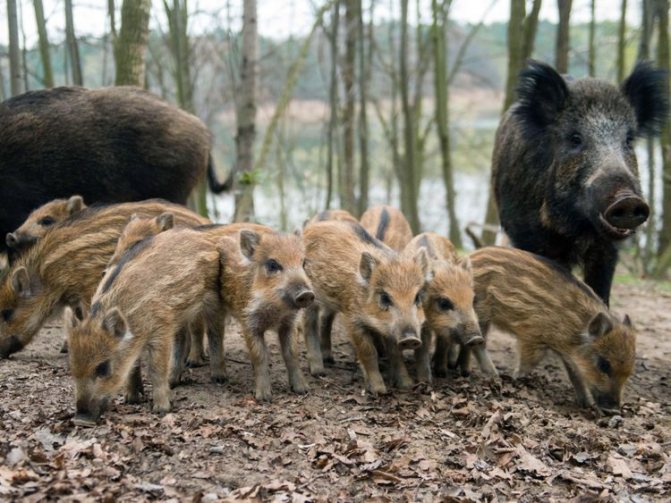
Despite its relatively small size, the boar is dangerous due to its strength, the presence of powerful jaws, fangs and sharp incisors, and its high speed of movement, so an encounter with it can have consequences in the form of bruises and serious injuries. Wounds from fangs can be quite deep, and on top of that, there is a danger of infection through them. Why is a boar bite dangerous? Serious diseases can be transmitted from a sick animal.
The danger also lies in disturbing the wild boar's territory and disturbing its afternoon nap. But foresters can pass by an animal, engrossed in its occupation, and not cause any disturbance to it.
Where can you find a wild boar?
Wild boars usually live near forests or near river valleys. Therefore, hunters know many ways to find a wild boar in the forest in summer or winter.
First of all, they can be found in places rich in food - where there is good soil, in which there can be a lot of insects, near ponds and swamps, where berries, nuts, etc. grow. Most likely you can meet a wild boar in the Siberian forests and forest-steppe.
In summer and autumn, wild boars prefer mixed forests of Siberia, rich in pine cones, surrounded by small ponds. In winter, wild boars are found in forests, fields, meadows and forest edges.
As noted above, the presence of wild boars is revealed by tracks, fur and dug up earth. They most often come out to feed in the evening and at night. This is interesting: How to make a chemical heating pad with your own hands
But they can also meet during the day. Usually a feeding boar in the forest can be heard far away.
And hunters, in order to meet an animal, need to wear clothes that do not rustle and move as silently as possible. But, if hunting is not part of your plans and you are just a tourist, then, on the contrary, try to make it as clear as possible to the wild boar that you are approaching so that he can get out of your way.
Of course, if you have not met these animals before, study the information and photos of wild boars in the forest in reference books in advance. This will make it easier for you to imagine what this beast is capable of.
Diagram and explanation of wild boar slaughter places
To stop the wild boar and not allow it to go into the forest and die there in vain and in agony, hit the most slaughter spots. These include the brain, heart and spine.
If the shot is fired at the killing places of the second and third categories (throat and internal organs of the abdomen), then several shots will have to be fired so that the prey is not lost. An adult male (cleaver), even in a seriously wounded state, often attacks a person, so you need to beat the wild boar in such a way as to deprive him of this opportunity. Experienced hunters recommend aiming at the following points:
- Brain. The most effective hit is at the point located between the ear and eye. This killing spot on a wild boar is small in size and it is better to target it using an optical sight or from a short distance. If you hit the thin part of the skull bone, you can hit the animal with one shot. If you make a mistake in aiming, the animal will be stunned, but not killed.
- Heart. The anatomy of the boar allows this vital organ to be hit only on the left. Having visually determined the outline of the scapula, target a point at its rear edge. If you hit the shoulder blade, you can wound the boar in the lung, which will not stop the animal, but will force it to leave, bleeding.
- A shot at the spine in the lumbar or cervical region will also be effective. A heavy bullet destroys the vertebrae and ruptures the spinal cord, depriving the animal of mobility. It is advisable to aim at these places from a short distance (20-25 m) to increase the possibility of spinal cord damage. In the cervical region, the slaughter place is located in the middle of the neck, in the lumbar region - in the middle between the withers and the base of the tail.
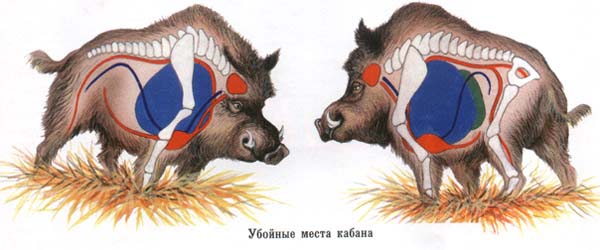
A charging animal must be shot in the center of the forehead or slightly to the right of the base of the neck in order to accurately hit the brain or heart and stop the boar with the first shot. This situation is the most dangerous, so the hunter will need all his self-control.
When shooting at a wild boar, when the boar moves away from the hunter, they aim at the middle of the back, trying to hit the spine or seriously wound the boar, hitting the lungs, heart or large blood vessels.
Actions after a wild boar attack
If you are attacked by a wild boar and you are injured, you should seek help from a doctor as soon as possible. Wounds must be immediately treated with clean water or soapy water.
Then get to the doctor or emergency room and describe in detail what happened, as well as the animal’s behavior. Most likely, you will need to take a course of rabies injections.
Expert opinion
Tarasov Dmitry Timofeevich
Master of Sports in mountaineering. Author of scientific articles on the topic of survival in the wild
Residents of the Nurabad district are outraged that a month after the death of a 17-year-old girl as a result of a wild boar attack, the authorities have not taken any action to protect people from the invasion of wild animals.
17-year-old Zohirai Tavakkal, a resident of Chepak village in Mujikharf village council, died from wounds received as a result of a wild boar attack. On that ill-fated rainy day, Zohira decided to visit a friend and was attacked by a wild boar, said her brother Muminsho Tavakkal.
“The body was discovered by our neighbor, who immediately informed us. Doctors said that the boar’s blow hit the neck artery, and Zohira died from loss of blood,” he says.
The Nurabad district prosecutor's office confirmed that the young girl died as a result of a wild boar attack.
Muminshoi Tavakkal says that several village residents were previously attacked by wild boars - they escaped with minor injuries. The number of wild boars in Tajikistan has been increasing in recent years.
According to Karomatullo Aliyev, an employee of the Mudzhikharf jamoat, the real disaster for local residents has been the raids of wild boars, which destroy the crops grown with difficulty. According to him, wild boars are not afraid of anything - neither people nor dogs, and even in winter they came to villages.
The authorities of the Nurabad region instructed hunters and local police officers to shoot wild boars in order to protect people and crops. However, a month after Zohira’s death, not a single wild boar was destroyed, residents are outraged.
Let us remind you that exactly five years ago, 10-year-old Nargis Saidakbar, a resident of the village of Karimberdy in the village of Khudoyor Radzhabova, Vose district, died as a result of a wild boar attack. Two young residents of the Shamsiddin Shokhin area also suffered from a wild boar attack.
Shomakhmad Khabibov, an employee of the Nurabad district forestry department, says that about 400 wild boars live in the Mudzhikharf gorge. According to him, in the past, during the winter, the number of wild boars tended to decrease, but over the past two years their numbers have been increasing.
Experts say that in the conditions of mountainous Tajikistan, female wild boars give birth twice a year: from 1 to 12 piglets are born. According to official data, about 12 thousand live in Tajikistan.
individuals of wild boar, but experts are sure that in reality there are many more of them.
In Tajikistan, hunting wild animals is strictly prohibited. However, according to government regulations, wild boar hunting is permitted in order to protect people and their crops.
True, people rarely shoot them, since no one needs the carcass of a wild boar now. Residents of areas bordering Afghanistan recall that during the presence of Russian border guards on the border, local hunters shot wild boars and the carcass was either sold or exchanged for fuel.
Meanwhile, according to experts, the destruction of wild boars can have disastrous consequences. “Intense hunting of wild boars can lead to people and domestic animals being attacked by other wild animals - wolves, jackals and even tigers.
These animals hunt wild boars and if their numbers decrease, they will look for food in human habitats,” says the famous Tajik biologist Khalil Karimov.
The boar's movements are clumsy, but fast; it swims excellently and can swim considerable distances. Vision is poorly developed: the boar does not distinguish colors and is not able to see a person standing 15 meters from him.
But the sense of smell, taste and hearing are very good. Boars are cautious, but not cowardly; when irritated, wounded or protecting their young, they are very brave and dangerous due to their strength and large fangs.
In recent years, in the mountainous regions of Tajikistan, people have built houses in permanent habitats of wild boars. In the east of the country, according to local residents, wild boars destroy the potato crop almost completely, run in herds and devour crops, leaving hectares of land “plowed” with their snouts...
I bring to your attention a diagram of wild boar slaughter places and a brief description with recommendations in this regard. I also gave general recommendations on wild boar hunting techniques during a collective driven hunt. I hope this article will help novice hunters who decide to take part in wild boar hunting. Remember that the wild boar is a dangerous and wound-resistant animal, and a wounded cleaver is especially dangerous ! Therefore, it is very important to know where and how to shoot! The result of the hunt and, possibly, your life depends on it! Remember, you shouldn’t panic while hunting and you need to maintain composure in any situation!
Content:
1. Wild boar slaughter places.
2. General recommendations for driven wild boar hunting.
3. How to hunt a wild boar from a tower.
4. How to hunt a wild boar from the approach.
5. Afterword.
Wild boar slaughter places
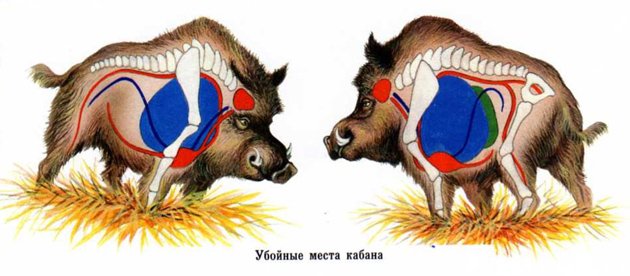
The main killing sites of a wild boar are: the brain , heart , lungs and spine .
The brain is a killing place, once in which you are guaranteed to kill the boar on the spot, but this is a task only a professional shooter can do. To hit the brain, you need to shoot in the central area between the ear and eye. If you are not confident in your abilities, then it is better not to shoot him! A boar's brain is very small, so it is a very difficult target; in addition, the animal is very mobile during a driven hunt, rarely stops, and it will not be easy to target it. If you miss the “place”, but the bullet hits the head, the animal will be stunned for a short time. He can lie down, convulsively and randomly kick! You shouldn’t approach him right away, as he can get up at any moment and attack the offender, or run away! It is best to stay on the number and keep your sights on the beast in order to get it if necessary!
Practice
I have had cases of successfully hitting a wild boar in the brain from short distances. 7.62x39 10 bullets . S.P. _ Hunted from ambush at night. This was several years ago, no photos.
At the end of August 2019 , I took a wild boar on an individual hunt from the approach, hitting it in the head from 35-40 meters. Read more about this in the section “how to hunt a wild boar from the approach.”
Also, in the same year, during a collective driven hunt, I was hit in the head by a cleaver from about 20-25 meters. Bullet, 124 gr. HPBT “Red Army Standard” manufactured by APZ Vympel , hit the upper left part of the forehead (almost the top of the head) and came out through the back, behind the right shoulder blade, stuck under the skin. It is noteworthy that the bullet did not open up and was almost not deformed (you can read more about these cartridges here, and about the hunt itself here). The boar, at the moment of the hit, ran towards me. After the hit, he tumbled and fell to the ground. Rolling over onto his stomach, he began to kick, paddling his hind legs powerfully and waving his tail vigorously. It seemed to me that he was about to blow himself up and run either towards me or away. I hit him with the second shot, an 8.0 g HP BPZ , in the area of the heart, waiting for the moment when the boar opens it.

Here's a video of how it happened:
On the next hunt, which was held in the same lands, I took a boar weighing 141.4 kg, standing at the same “number” as the last time. The cutter received a bullet in the head from about 20-25 meters. I shot with the Centaur half-shell. The bullet entered under the left eye. The boar collapsed instantly. I didn’t have to get it, although he kicked a little, about 20-30 .
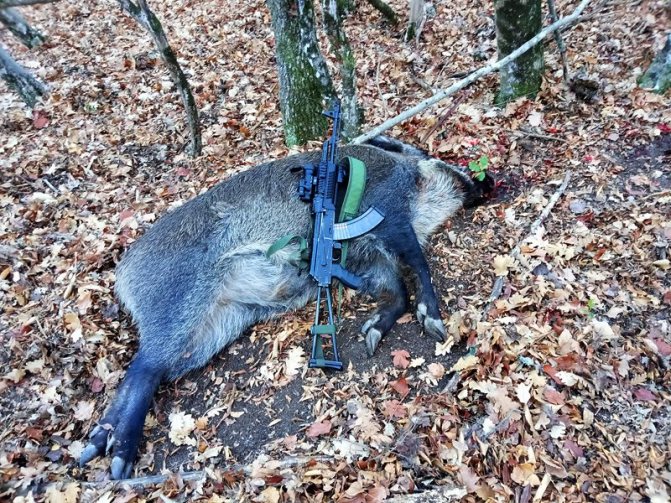
Here's how it went:
The heart is a very good killing place, but getting into it is also not very easy. To hit the heart, you need to determine the outline of the shoulder blade and shoot at a point near its back edge. In this case, the lungs of the animal are also affected, which is also fatal, but if you do not hit the heart, a boar with punctured lungs will still be able to overcome some distance, up to several hundred meters. And getting into the heart does not guarantee 100% that the animal will die on the spot. There are cases that a cleaver with a broken heart can run about 100-120 meters!
To be honest, I try not to shoot in the heart, since I take liver (heart, liver and kidneys) from shot down wild boars.
The lungs are a killer place that is not difficult for a novice hunter to get into. However, this wound cannot guarantee that the beast will be put down on the spot! There are cases that a wounded animal can go a considerable distance (up to 300-500 meters). To hit the lungs, shoot the animal under the shoulder blade and you won’t miss. In the diagram at the beginning of the article, the lungs are shown in blue. As you can see, this is a fairly large target. It is best to wait for the moment when the boar is sideways to you, then you are guaranteed to be able to hit both lungs.
Practice
In my practice, in 2018 two ( 96 and 120 kg) of three rather large boars on the spot, shooting in the lungs, but apparently the decisive role here is played by the suddenness of the shot, the state of the animal (on adrenaline the boar is much stronger in the wound), the bullet , more precisely, its damaging ability and what it destroys along with the lungs (ribs, bones, etc.) and the presence of a state of shock in the animal after being wounded. The third boar ( 65 kg gilt) quickly ran towards me head-on and received a bullet under the snout, in the right sternum, from a distance of about 5 meters! He was on adrenaline and didn’t lie down right away, turned sharply to the right and ran about another 40-50 meters, then died. An autopsy showed that there was nothing left of his lungs. However, I prefer to shoot at this killer spot, or at the next one below.
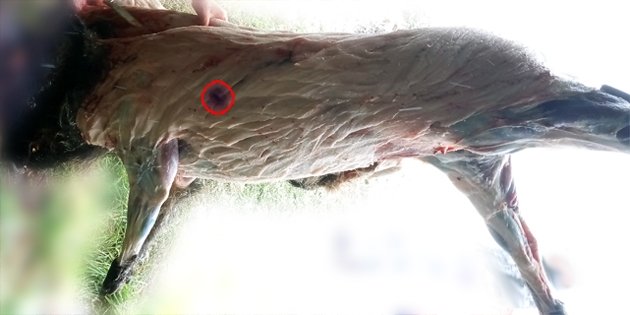
The first boar in the photo weighs 96 kg, the second - 120 kg. Both fell immediately, but kicked a little.
In 2019 , during a collective driven hunt, I caught a pig weighing 97 kg. She was wounded by a nearby shooter (the bullet hit the withers without hitting the spine). The pig and three more boars flew towards me, at full speed. 8.0 g HP BPZ bullet hit the left side, behind the shoulder blade. The wound is through, exiting through the right side of the chest, at the base of the right front leg. In the cases described above, the boar died immediately. But in the case of the wounded pig it turned out differently. After being wounded, the wounded animal ran without slowing down for about 150-160 meters, then fell on its side. After 5-10 seconds, the boar stopped showing signs of life.
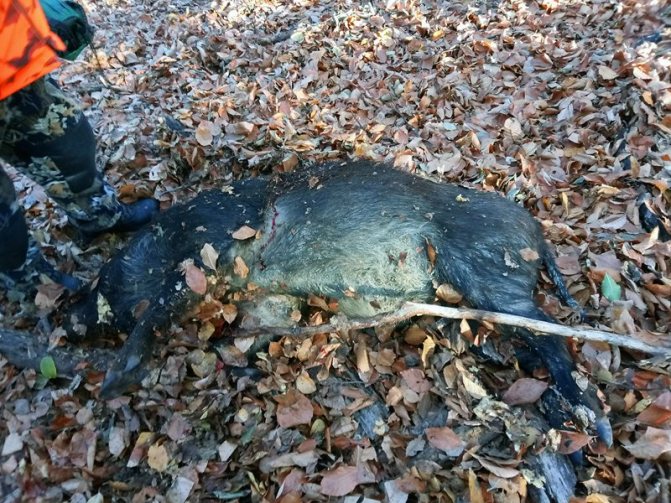
Video of how it happened:
On one of the subsequent hunts I caught two wild boars in one pen. Both were struck in the lungs. However, 90 -kilogram boar to lay down in place; as a result, he received 3 bullets. The first hit him on the left side, just behind the shoulder blade. The wound is through. Despite the wound, the beast ran at full speed with its lungs punctured. The second bullet slightly touched the intestines, also piercing the lungs, exiting through the right shoulder blade. The beast ran without slowing down. The third bullet hit the back of the head in the neck, the hollow bullet spun wildly and exited through the forearm of the right front leg, damaging the vertebrae. At the moment the last bullet hit, the boar was literally blown off its hooves and fell enchantingly. 67.5 came running towards me . The semi-shelled "Centaur" knocked down the unfortunate pig, piercing it right through, simultaneously piercing its lungs and destroying a couple of bones. The bullet exited through the forearm of the right leg. One bullet was enough for him.
Here's how it went:
The spine is a very good killing place. A shot in the cervical or lumbar region of the vertebra in most cases is guaranteed to put the animal in place, destroying the spinal cord and paralyzing it. But there are times when the animal tries to escape with its hind limbs paralyzed, rowing on its front limbs. It is recommended to get it in this situation! On one of the hunts, I caught a wounded wild boar weighing 90 kg, hitting its vertebra with the half-shell, between the withers and sacrum. The fast running boar collapsed instantly and never moved again! But getting into the spine is not very easy. If you want to hit him in the cervical region, then shoot at the center of the neck, at the lumbar region - in the middle between the withers and the base of the tail.
I came across recommendations from some “experts” on the topic that you still need to shoot in the liver . I don’t see any point in this for several reasons, first, the beast will not die on the spot 100% , second, as I said above, I’m taking the heart and liver and I need them safe and sound, thirdly, you will learn a lot of new things about yourself and unusual from your fellow hunters, in case of rupture of the gallbladder, intestines and stomach, since the meat will be guaranteed to be 100% spoiled!
Having talked about wild boar slaughter places, I think it is important to dwell on hunting techniques and techniques.
General recommendations for driven wild boar hunting
If you are a completely newbie who has just bought his first gun in his life, and a double-barreled one at that, you have never been on any kind of hunting, you don’t know how to shoot quickly and accurately, you are not confident in your abilities, and in general, If you have no idea what a collective driven wild boar hunt is, then you are categorically not recommended to join the “number”! But if you still decide on this adventure, then these tips will help you not to do anything stupid.
Know that a wild boar is very dangerous for humans, especially a wounded one!!! Even a small pig can knock down an adult and cause serious injury!
1. Never use buckshot! As a rule, the timing of a collective wild boar hunt coincides with its rutting season (mating season). The racing cleaver is reliably protected by the Kalkan and buckshot most likely will not penetrate it! And if it hits, it will not be able to inflict serious damage on the hog. Shooting at a boar will only anger it and it may attack you!
2. When hunting, you need to be able to maintain composure and not give in to panic! Try to make decisions soberly and carefully! It is very important!
3. Try to find natural obstacles and barriers in your “room” (trees, large boulders, etc.) that can protect you from a wild boar attack, stand next to them. If your shooting position is “gol-moth”, then try to stand in an open area so that in the event of a wild boar attack, you can quickly jump away from the boar rushing towards you. This “maneuver” must be done at the last moment, right in front of the boar’s face! Usually, after a mistake, the boar does not return to the hunter. But there are exceptions, but this happens extremely rarely.
4. There are situations when an animal flies out at you head-on! In this situation, there are two options: first, shoot him in the center of the forehead to hit the brain or in the left sternum of the beast, under the base of the neck (from the shooter's side, the right side of the charging boar)! If you are not confident in your abilities, jump to the side and shoot when the boar is turned sideways towards you, or, letting it pass the shooting line, into the drive (but do not shoot at the “dupa”, try to hit the spine or lungs). Very important! Do not shoot along the shooting line so as not to injure your comrades!
5. In order not to miss or become a “butt shooter”, do not forget to take the correct lead when shooting at a running boar, especially with a smooth-bore weapon, since the speed of a “smooth-bore” bullet is much lower than that of a rifled one! Here is an example of the correct lead when shooting from a rifled carbine, the initial bullet speed is 800 m/s:
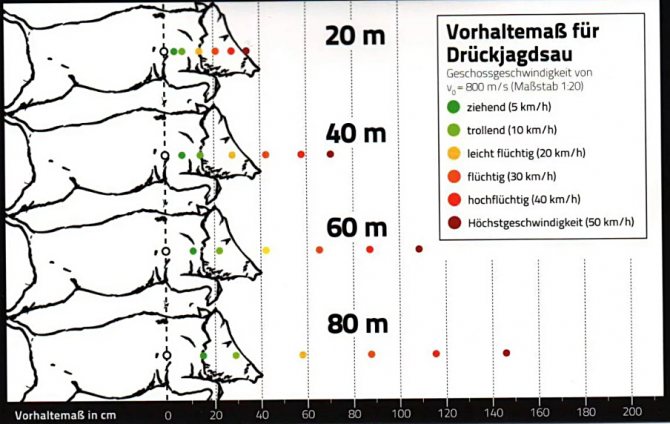
For smooth-bore weapons, the lead given above can be multiplied by 2!
6. You hit a boar and it lies down and doesn’t get up. Don't rush to approach him right away! Firstly, it is strictly forbidden to leave the “rooms” until the corral is completed. Secondly, the boar may be alive and he is waiting for the offender to approach in order to take revenge! It is worth paying attention to his ears, tail and mane. If the ears and tail are pressed down and the mane is standing on end, the boar is alive and ready to attack! You need to wait until he “reaches”, or get him with a second shot.
How to hunt a wild boar from a tower?
If you hunt from a tower, then the situation here is much simpler. Firstly, you are in a safe shelter and do not risk your health, unlike driven or individual hunting from the approach, where there is a high probability of running into a wounded and not very kind boar, which intends to give the hunter an easy run, so to speak. Secondly, you will be shooting at a calm animal, which will most likely be quietly and peacefully eating food at the feeder; in such a situation it is not difficult to hit the animal in the “place”, the main thing is to follow simple recommendations:
1. While on the tower, try to behave very quietly so as not to frighten the wild boar, since its hearing is very well developed, and it is also not recommended to husk the seeds.
2. In addition to hearing, the wild boar has a superbly developed sense of smell, so it is better not to smoke on the tower, and also do not douse yourself with perfume before going hunting.
3. When the boar or boars come to the feeding trough, calmly assess the situation without getting nervous; if the animal meets your criteria, quietly and without unnecessary sounds take aim at the animal. Decide which slaughter place you will shoot at (the list of slaughter places is at the beginning of the article). If you are a novice hunter, I advise you to shoot in the lungs , since this is a fairly large and convenient target (shoot the animal under the shoulder blade and you won’t miss). A calm and relaxed feeding boar has a 90% of instantly falling over on its side.
4. Wait until there are no obstacles between you and the animal that would interfere with your view and shot, and also until the moment when the wild boar is turned towards you from a convenient angle (the most convenient option is sideways) and fire the shot. Be prepared to quickly fire a second shot in case the animal does not fall or has fallen and is trying to get up to run away!
5. I repeat, this is also true for hunting from a tower. You hit a boar and it lies down and does not get up. Don't rush to approach him right away! Since the boar may be alive and he is waiting for the offender to approach in order to take revenge! It is worth paying attention to his ears, tail and mane. If the ears and tail are pressed down and the mane is standing on end, the boar is alive and ready to attack! You need to wait until he “reaches”, or get him with a second shot.
It often happens that a hunter begins to experience an influx of adrenaline when a wild boar appears, and a novice shooter may also experience a panic attack. Your heart rate and breathing quicken, your hands begin to tremble. In this situation, try not to lose your composure, calm down, don’t get nervous, pull yourself together (as much as possible), breathe evenly, deeply and calmly. Despite the strong excitement and stress, try to control yourself and not make noise, so as not to scare off the animal and not return from the hunt with nothing. After catching your breath a little and calming down, try to continue hunting.
How to hunt a wild boar from the approach?
Perhaps this is the most interesting way of hunting wild boar, which requires serious skills and self-control from the hunter. You need to skillfully and quietly detect the animal, come within shooting distance without spooking it, and, in fact, shoot accurately. In my opinion, the recommendations would be the following:
1. Don't make noise! Walk very carefully and quietly, try not to step on dry branches and twigs, and do not make noise with dry leaves under your feet. If you go with a huntsman, speak only in a whisper, only to the point!
2. Don't smoke! Do not use perfume before hunting.
3. Try to approach the animal from the leeward side.
4. Having spotted a wild boar(s), get as close as possible (as far as possible). Don't scare me away!
5. Having chosen a suitable individual with the huntsman, quietly take aim at it. Decide what killer place you will shoot at.
6. After waiting for the right moment, when the animal is conveniently standing next to you, open fire. Be prepared to fire a second shot quickly and accurately if necessary.
7. I will repeat again. You hit a boar and it lies down and does not get up. Don't rush to approach him right away! Since the boar may be alive and he is waiting for the offender to approach in order to take revenge! It is worth paying attention to his ears, tail and mane. If the ears and tail are pressed down and the mane is standing on end, the boar is alive and ready to attack! You need to wait until he “reaches”, or get him with a second shot.
If you hunt at night, do not use a flashlight, as the light will scare away the wild boars before you get close to them. Use NVGs or thermal imagers.
At the end of August 2020, I took a wild boar on a night hunt from the approach. Then I had to wander with the huntsman through the hunting grounds half the night. Either there were no boars at all, or there were sows with young-of-the-year piglets. But, at three o'clock in the morning, at one of the feeders, luck smiled at us. A small group of three approximately identical boars was feeding. Selecting the boar standing in the middle. Shooting distance 35-40 meters, hit in the head, under the left eye (brain destroyed). The animal lay down instantly and for a short time twitched its hind legs chaotically. For hunting at night, Dipol d128 night vision devices (version 2+) and Pulsar thermal imagers were used.

Afterword
As practice shows, sometimes a double-barreled shotgun is a direct path to injury and death of an inexperienced shooter! There was such a case, a hunter I knew told me about it, when an elderly, but seemingly experienced hunter went hunting with a double-barreled shotgun, leaving a powerful semi-automatic carbine at home (due to greed, they say it’s a pity to kill an imported carbine and the cartridges for it are very expensive ). A cleaver ran out at him, the hunter opened fire, shot off his back hoof with the first bullet, but missed with the second. If my acquaintance had not come running to his aid in time, then this unfortunate hunter would have had an eternal memory! The boar overpowered the man and began tearing him with his fangs and gnawing with his teeth, climbing his entire carcass onto the poor guy’s back. The hunter who came to the rescue scared off the cleaver with a loud cry, and while the boar was accelerating to strike the second hunter, the semi-automatic .30-06 showed the boar the light at the end of the tunnel, feeding him 3 bullets. The grandfather was hit very hard, the boar tore his ass and legs into rubbish, somehow patched up, he was taken to the hospital. Since then, he no longer takes a gun with him on wild hunts, now only a carbine.
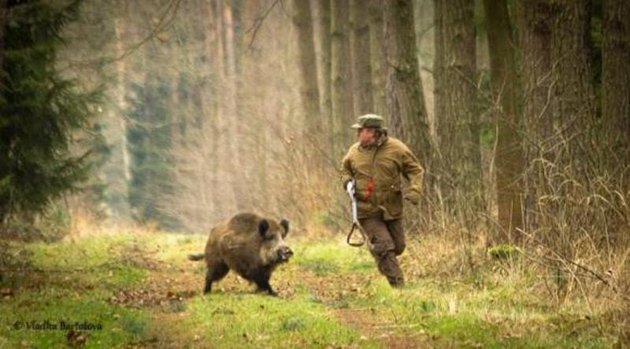
Why am I saying this? When using a double-barreled shotgun in a driven wild boar hunt, you need to be very collected and attentive, you need to shoot very accurately. But even with experienced hunters, unpleasant things can happen. This case is not the only one when, due to the inability to make the third shot, a hunter is on the verge of death. There was such a case in our hunting team 3-4 years ago: an inexperienced hunter with a double-barreled shotgun was lucky enough to meet a cleaver. The shooter waited until the boar passed him and shot him in the ass with his gun, missing with the second shot. The boar, upset by this circumstance, rushed at the hunter. Here a miracle saved the day; the wounded “professor” slipped on a slippery slope and fell, only slightly hitting the shooter, thereby giving the would-be hunter time to reload. The finale of the scene was a double shot to the boar's snout, almost point-blank. But the air smelled of courage thoroughly and the shooter’s ass then shrank colossally!
If possible, take a multi-shot weapon and, preferably, a semi-automatic one, so as not to find yourself in a similar situation, especially if you are not an experienced shooter and cannot be guaranteed to hit the beast in the “place” the first time.
You might be interested in:
Radio station Baofeng UV-5R
During round-up (driven) hunts for ungulates, more and more hunters in our hunting team use walkie-talkies, and in addition to hunters, huntsmen and beaters also use walkie-talkies. Firstly, it is very convenient, since you are always aware of events, quickly receive all the necessary information, for example about the animal in the pen, the direction of its movement, the results of shooting, etc.; secondly, in the Crimean Mountains there is practically no mobile communication everywhere, and it is very important to be able to quickly contact your comrades, especially in the event of an emergency. Therefore, my father, my friend Eduard and I decided to keep up with technological progress and acquired these devices. The choice fell on Baofeng UV-5R .
Read more…
Brown hare
The brown hare (lat. Lepus europaeus) is a mammal of the genus of hares of the order Lagomorpha. It is a very common mammal, found on all continents except Antarctica. The brown hare is a steppe animal, but also lives in forest-steppes, open forests and tundras. Belongs to the genus of large hares. Body length from 55 to 70 cm, height at withers 25-30 cm, body weight from 4 to 7 kg. It feeds exclusively on plant foods. It is the object of commercial and amateur hunting. The average life expectancy is 6-7 years, the maximum can reach 10-12 years.
Read more…
HiViz fiber optic front sight for AK
At his father’s request, he bought him a fiber-optic front sight for his hunting AKMS (Fort-201), since, he says, his eyesight no longer allows him to comfortably use an open sight in the forest, especially in cloudy weather. A collimator sight is “not a horse’s feed” for him, so only an open sight is needed. I didn’t have to search for long; in one of the online stores I checked, I ordered him a HiViz AK2010 , and at the same time additionally ordered him a plastic 20-seater magazine. And today they decided to install it on his carbine instead of the standard one...
Read more…
Share with friends!
Dear users!
Comments containing insults, obscene language against representatives of other races and nationalities, faiths and religions, as well as advertising will not be published.
Expert opinion
Tarasov Dmitry Timofeevich
Master of Sports in mountaineering. Author of scientific articles on the topic of survival in the wild
The recommendations from this article can save your life: find out what to do when you encounter a wild boar in the forest and how to avoid this encounter.
The wild boar (also known by the party nicknames boar, boar and cleaver) lives everywhere in the forests of the middle zone, Siberia and the forest-steppe. And according to hunters, this herbivorous creature in certain situations is much more dangerous than predators, since when enraged it knows no fear and completely loses its sense of self-preservation.
Wild boar attacks on humans in most cases result in the death or severe injuries of the latter. This topic is quite serious - and therefore it is better for everyone who often visits the forest to know in advance how to behave when meeting a wild boar.
Informed means armed.
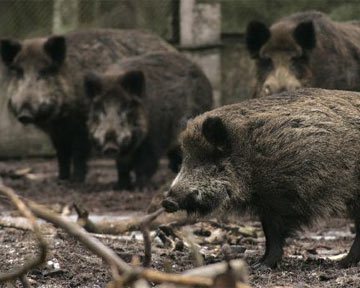
How to determine if there are wild boars in the forest?
Boars leave characteristic marks on the wet ground - a sharp cloven hoof. The litter in their habitat is in some places dug up in short strips about 10 cm wide: wild boars dig through the fallen leaves, looking for nuts, acorns and other pork goodies underneath.
They also like to wallow in the mud, thus getting rid of skin parasites: they found a hole with water in the forest after rain, the entire bottom of which was dug up by hooves - it’s better not to linger in this place.
In addition, residents of surrounding villages, summer residents, hunters, and foresters most likely know whether there are wild boars in the forest or not. Ask the first person you meet at the nearest railway station - perhaps he will give an answer.
Are wild boars dangerous? Do wild boars attack people?
This is interesting: Hunting beaver with a gun in the fall
Often, a wild boar attack on a person is provoked by the person himself. In the minds of many, a pig is a good-natured animal with a pink patch that should not be feared.
However, a boar is not a domestic sow, but 300 kilos of meat with fangs, so if you see it in the forest, try to leave the meeting place unnoticed, be it a piglet or an adult animal. Boars see and hear worse than humans, so it is quite likely that you will notice him, but he will not notice you.
Wild boars, like any other forest animals, themselves try to avoid meeting people - therefore, if a boar does notice you first, there is a good chance that it will also hasten to hide. But here, too, a problem is possible: the sensible pig will leave, and the stupid one will sit somewhere in the bushes and wait until you leave the field of view.
If it so happens that your route runs past those very bushes, the animal’s nerves may fail and it will attack, fearing possible aggression on your part. This situation is dangerous because it is extremely difficult to escape from a cleaver jumping out right at your feet, since it becomes too late to take any action.
Wounded cleavers are very dangerous. If the boar hunt fails, not only will the hunter be torn to pieces, but so will every person the vengeful boar encounters. Therefore, it is highly not recommended to shoot wild pigs with small-caliber weapons: if you kill them, you won’t kill them, but they will make you very angry.
Pigs with piglets, contrary to popular belief, attack hunters extremely rarely - in case of danger, they prefer to save themselves rather than rescue their offspring. But it is better for an unarmed tourist not to try to drive the brood away from the camp with screams if the minke whales start rummaging through the backpacks in search of food.
In a similar situation, one of my friends fired a flare into the air: the pigs and their mother, frightened by the unfamiliar loud sound, immediately ran away. And he would have started waving his hands at them - it remains to be seen whether he would have told me this...
By the way. When defending yourself from a boar with a hunter’s signal, shoot in the air, and not at the animal: set its skin on fire - it’s your own fault... It’s impossible to kill a creature of this size with a rocket, it’s impossible to inflict a mortal wound, too, and if you manage to blind, it won’t help you escape: an angry boar will attack at sound.
How to escape from a wild boar?
“There are boars in this forest, so wherever you go, sing loudly,” our instructor once said, and I now advise the same to beginners. Since it is much more difficult to protect yourself from a boar than to avoid meeting one, the latter should be your goal.
Expert opinion
Tarasov Dmitry Timofeevich
Master of Sports in mountaineering. Author of scientific articles on the topic of survival in the wild
A person does not move through the forest silently: a sensitive animal hears the steps of a stranger and leaves. The voice can be heard beyond the steps - allow the wild boar and other living creatures to give way to you, so that your meeting is guaranteed not to take place.
What to do when meeting a wild boar if your paths do cross? Without waiting for signs of aggression on his part, climb the tree. Not necessarily high: pigs cannot jump like wolves or climb trees like bears.
One meter above the ground is enough. If there is no vegetation nearby with low-lying branches that you can grab onto, grab the trunk at the level of your head (it is better if it is as thick as your arms or less), and, resting your feet on the bark, pull your legs under your stomach.
If you have enough strength, climb further as if on a tightrope. When the boar disappears from view, go down to the ground. Keep in mind that an angry animal can keep you suspended for several hours, so it is better not to shout at it or throw pine cones.
Do not try to run when you meet a wild boar in the forest: boars run faster than people. An angry cleaver can even catch up with a cyclist.
Clubs, bladed weapons, shockers, and pneumatic/traumatic weapons are also extremely ineffective: only a head shot from a large-caliber firearm can stop a wild boar. If you don’t have a good-quality hunting rifle in your hiking backpack, don’t waste precious seconds trying to defend yourself - save yourself in a tree and stay alive.
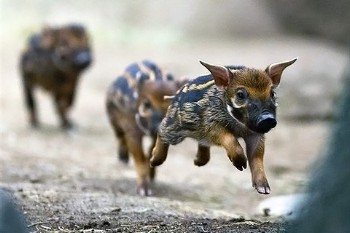

Rules of behavior when meeting
The meeting is sudden only for a person. The boar, having an excellent sense of smell and hearing, learns about the appearance of a stranger in advance. If it is possible to avoid conflict, the beast will bypass the person.
When meeting a wild boar in the forest, it is recommended to take the following actions:
- Don't panic.
- Try to quietly, without making sudden movements, walk around the animal. If the boar is close, talking, singing, whistling, tapping—any noise that attracts attention—helps. Even the sound of a mobile phone can scare away a boar. There is a high probability that after this the animal will hide in the forest. The ideal option is to shoot into the air from any weapon.
- When creating noise, it is important not to cross the line: the animal will perceive movements in its direction, too active swings as aggression.
- If a boar runs directly at a person, and there are no trees nearby, it is recommended to turn sharply to the side at the moment of the attack. The wild boar is a powerful but clumsy animal. By inertia it will run a few more meters. Next, you need to gradually move away towards some kind of shelter or tree.
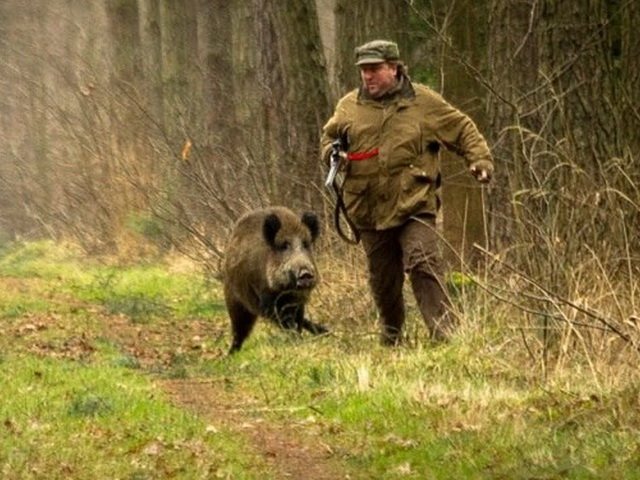
- The best option to escape from the beast is to climb a nearby tree. A meter or one and a half meter height is enough to be safe. Unlike bears, boars cannot climb trees. They are not able to jump high like a wolf. A boar will not be able to reach a person. However, a very angry wild pig will not leave quickly and may spend many hours waiting for the offender to come down from the tree. The person will just have to wait until the beast retreats.
- Sticks, stun guns, gas canisters, and smoke bombs will not help against a wild boar.
- It is very difficult to kill or seriously injure a wild pig with a knife; not every experienced person, let alone an ordinary person, can cope with the task. It’s easier to neutralize a boar with an axe, but you need to hit it accurately and hard on the spine or head.
- If a wild boar attacks, you should not use small-caliber weapons against it. A wounded boar will only become angrier. You need to shoot with a powerful weapon with a strong stopping effect.
- Piglets should be avoided even in the absence of a queen. Do not pick them up or take photos or videos with them. This is dangerous as the wild pig may return unexpectedly. Piglets need to be scared away with sound.
- Don't run headlong from a wild pig. There is extremely little chance that this will be possible. A running object will only provoke the beast.
- Do not turn your back to the animal. This gives the beast a chance to attack an unprotected enemy.
- Avoid staring. Staring is perceived as a challenge.
- Do not feed wild animals at rest stops.
Description
Perhaps everyone can imagine what a boar looks like. This distant relative of domestic pigs has an elongated head, snout, and large ears.
Strong, long legs help the wild boar make its way through impenetrable thicket and bushes. The fangs stick out, they are large and sharp.
Thanks to this structure, wild boars repel enemy attacks. Males have longer fangs than females.
Another means of protection from enemies is thick bristles.
Boars do not move particularly gracefully, but quickly. Capable of swimming long distances. These wild animals are cautious, but not cowardly.
Boars' vision is not very sharp, but their hearing and sense of smell are well developed. This allows them to successfully obtain food.
The diet of these animals consists of plants, insects, snakes, nuts, berries, roots, and bird eggs. Occasionally, wild boars attack wounded fallow deer or deer and eat them.
The predator goes for food in the early morning or during twilight. During these periods, the likelihood of encountering a wild boar in the forest increases.
Habitats
Wild boars prefer swampy areas and proximity to bodies of water. There is more food for these animals. In summer and autumn, boars choose mixed forests surrounded by small bodies of water. In winter, these animals are more often found in fields, meadows and forest edges.
In Russia, such representatives of the animal world live in the Caucasus, Southern Siberia, and vast territories of the European part, with the exception of the tundra and taiga in the northeast.
This is interesting: Hunting for a raccoon dog and a raccoon
Boar
The wild boar is an ancient artiodactyl mammal from the suborder Porciniformes (non-ruminants), the family of pigs.
Where does it live?
Wild boars are found in the zone of mixed and deciduous forests of the Eurasian mainland (in the steppe part), in the Mediterranean regions, in Central and Western Asia. In Russia, the wild boar is distributed in the European part (excluding the northeastern regions of the tundra and taiga), the Caucasus, Southern Siberia, and the Tien Shan. The wild boar is the only representative of the pig family in Russia.

What does it look like
The wild boar, or wild boar, is a large animal with a short massive body, a thick short neck, relatively thin short legs and a short tail. Body length up to 175 cm, height at the withers - up to 100 cm, weight - up to 320 kg. The ears are long and wide, the muzzle is elongated and ends in a snout. The hairline is rough and bristly. Color ranges from black to reddish-brown and gray. The piglets are light brown, with light yellowish stripes on the back and sides. This coloring helps them hide from enemies.
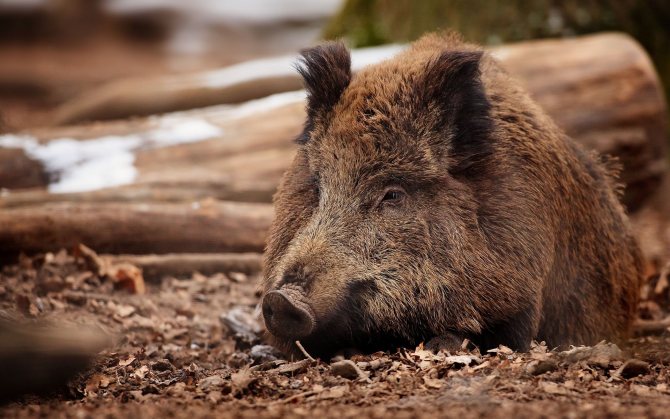
This color allows him to be invisible in the forest
The wild boar is the ancestor of the domestic pig. It differs from it in that it has a shorter and denser body, thicker and higher legs; in addition, the boar's head is longer and thinner, its erect ears are longer, sharper, and its tusks are larger and sharper.
Lifestyle
Wild boars lead a herd lifestyle, with the size of the herd changing throughout the year. Adult males (cleavers) stay solitary and approach females only during the breeding season.
In the territory where wild boars live, there are places where these animals rest (usually they are located among bushes, stones or in heaps of reeds), feeding areas and mud “baths”. All of them are connected by boar trails. Animals often make large dens of dry grass, reeds and branches. In each den, females rest with piglets (up to one year of age), and males arrange separate dens for themselves.

Boars are omnivores. All year round they feed on roots, rhizomes, tubers, plant bulbs, and, depending on the season, on shoots, seeds and fruits of plants, as well as animal food: worms, mollusks, insects, mice, frogs, lizards, snakes, and also eat carrion. During the day, a wild boar eats about 2.5 - 6 kg of food.
In summer, wild boars are active at night, and in winter they feed during daylight hours. They can visit fields of potatoes, turnips, and grains, where they cause harm to agriculture, especially by tearing up and trampling crops.
The boar is a clumsy but fast animal; it swims excellently and can swim considerable distances. His vision is poorly developed, but his sense of smell and hearing are very good. Boars are cautious, but not cowardly. Whether irritated, wounded or protecting their young, these strong, sharp-tusked animals are very brave and dangerous. Besides humans, wild boars, mainly young ones, are threatened only by wolves and lynxes, and in the south of the Far East by tigers, which, however, rarely attack. The wild boar was domesticated by humans for its tasty meat.

Hunting for wild boar is dangerous, as the animals often rush at the hunters, and the male cleavers inflict lacerations with their powerful fangs. Females, whose fangs are less developed than males, knock unwary hunters off their feet and trample them with their front feet.
In heraldry, the wild boar is a symbol of courage and fearlessness.
During the breeding season, wild boars rub against the trunks of spruce and pine trees. As a result, old wild boars develop a kind of armor made of a mixture of resin and sticky bristles on their backs and sides. During fights between males, this shell protects the animal’s sides from blows from the enemy’s fangs.
Reproduction
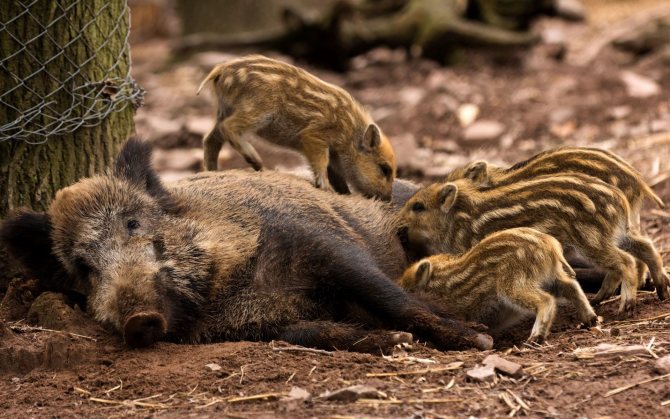
In March - May, females give birth to piglets. Usually there are 4–6 of them, but sometimes up to 10–14. The female carefully guards the cubs and bravely protects them from enemies.
Danger to humans
The behavior of the wild boar is distinguished by caution, but if wounded, being near the cubs, the animal is dangerous: with its tusks it is capable of inflicting serious wounds. A boar can attack a hunter. Boars become especially ferocious if they are scared off during “lunch” or if a person approaches a female with cubs. The male strikes the man with his fangs, the female, having knocked down the hunter, kills him with her front legs.
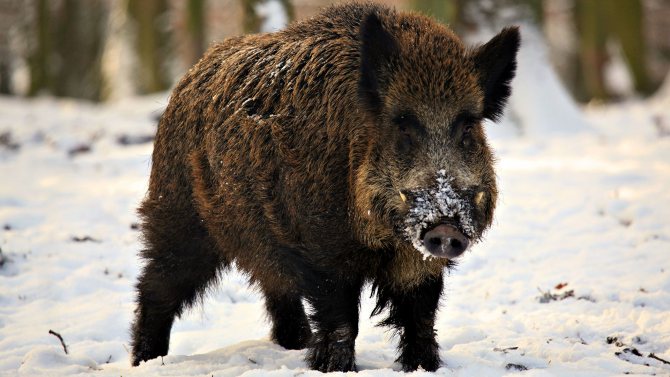
An adult male wild boar is called a cleaver
If a wild boar runs at a person, you should quickly move away in front of the animal, having rushed past, it is unlikely to return for a new attack. The most dangerous are adult animals that live alone. The wild boar has a large number of parasites, and therefore it often rubs against the bark of trees. Because of this, growths of tar and dirt appear on its back, which protect the animal from bullets.
How to avoid encountering a wild boar
Traces of a wild pig can be identified by hoof prints, dug up soil, and tufts of fur. To prevent a meeting between a person and a wild boar, you need to warn about your presence.
To do this, it is enough to stomp loudly and rustle clothes. A signal flare that is fired into the air is considered a good tool. These methods will help you avoid communicating with a dangerous representative of the animal world. He'll just get out of the way.
Or the tourist himself may back down. Usually the boar does not eat very carefully; its eating can be heard from afar. This means you shouldn't go in that direction.
Rules of conduct if you meet a wild boar
Expert opinion
Tarasov Dmitry Timofeevich
Master of Sports in mountaineering. Author of scientific articles on the topic of survival in the wild
To protect yourself in wild boar habitats, move loudly, sing or talk. Thus, the animal will hear and hide from you at a great distance.
If your paths do cross, under no circumstances run from the wild boar. Immediately climb a tree, 1 meter above the ground is enough, a boar is not a wolf to jump up and not a bear to climb after you.
But an overly offended animal can wait for you downstairs for several hours, so don’t shout at it or throw anything at it; it won’t scare it.
If a wild boar is running towards you head-on, and there are no trees nearby, you can try to jerk sharply to the side. The animal will run past and there is a chance that it will not come back.
And having received a second head start, while the boar comes to its senses and turns around to look for you, run away to shelter or trees. If the boar rushes at you again, repeat these maneuvers, dodging and gradually approaching the shelter.
Most likely, sooner or later the boar will get tired of it and run away. If you come across someone who is seasoned and persistent and angry, you are in serious danger.
Resorting to defense with a club is a bad option; it will not have any effect on the boar. A knife is only for luck and only if you know how to handle it well.
A well-sharpened machete, kukri, or ax will only work with an accurate and strong blow to the head or spine. Even a shot from a large-caliber gun at a wild boar must be made very accurately.
Otherwise, you will only hurt him and make him even more angry. A stun gun will not work on a wild boar, a gas canister is ineffective, and a smoke bomb, which can scare away a wolf and even deprive a bear of the desire to attack, will also have a bad effect on a wild boar.
In general, the best option is to climb a tree and wait for the boar to leave.
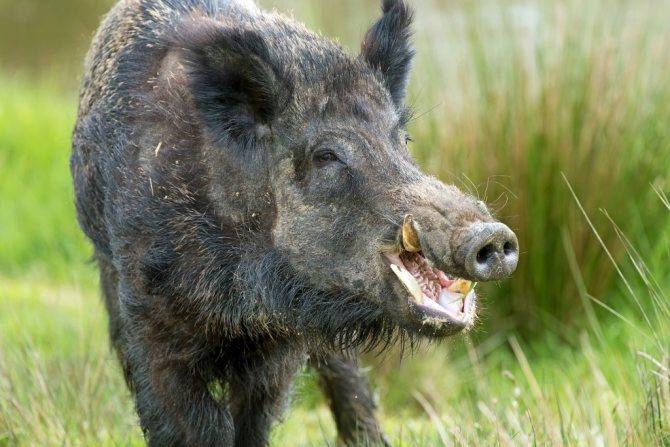
a wild boar
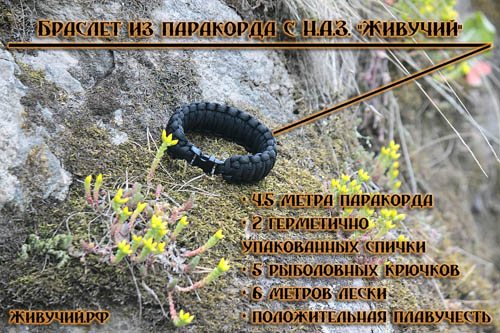
Buy a survival bracelet with a wearable emergency supply
Expert opinion
Tarasov Dmitry Timofeevich
Master of Sports in mountaineering. Author of scientific articles on the topic of survival in the wild
The wild boar is a representative of the artiodactyl order. This animal is also called a boar. Tamed by distant ancestors, he became the progenitor of domestic pig breeds. In areas where there are a lot of wild boars, the animals can harm the forest.
Wild boars destroy bird nests and feed in fields and vegetable gardens. Boars can attack hunters and pose a serious danger.
To learn about safety when meeting a wild boar, you should study its habits.

The character and habits of the boar
The wild boar is a nocturnal animal that is accustomed to roost and feed in one place, provided they are safe. An experienced hunter carefully examines the area and finds traces of the animal. Clear signs of the presence of a wild boar are trampled clearings and damaged roots. Under no circumstances should you smoke or drink alcohol while hunting wild boar, as these animals have a very delicate sense of smell. Also, before hunting, you need to avoid overly smelling shampoos and deodorants. When approaching, you need to approach from the leeward side. The boar is taken from the approach wearing moccasins made from boar skin, the wool of which is turned outward. In such shoes you can move silently, which will allow you to get close to the animal while it is feeding, making characteristic sounds.
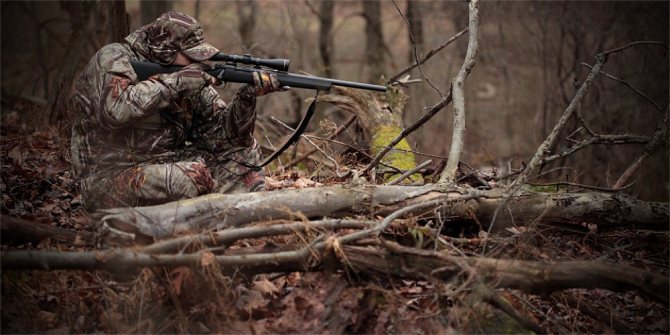
The distance suitable for shooting should not exceed 25 meters. The caliber should be 30-06 or 7, as well as 62 x54R. It is advisable to take a place close to cover before you start shooting. A huge boulder or tree trunk can serve as such a shelter. If the shot is unsuccessful, you can hide behind them from an angry boar. He will not dare to repeat his attack; as a rule, if a boar rushes past the hunter, he prefers to run away.
Appearance, character and habits
The sight of a boar speaks of strength and ferocity. The shape of the body and strong legs help to get through bushes, and sharp fangs protect against enemies.
- elongated head;
- long legs;
- erect ears;
- large fangs;
- hard fur.
The muzzle, tail and body are black, dark brown, black-brown. Small individuals weigh 45 kg, large ones - up to 300 kg. Animals reach up to 2 meters in length and 110 cm in height. Males have long fangs, females short.
The offspring have stripes on the body, which allows them to camouflage themselves from enemies. Females live in groups of up to 50 individuals, in which an experienced female is the leader.
Males lead a solitary existence and visit the herd only during the mating season. At night and during the day, wild boars like to rest. They go out to feed at dusk or early in the morning.

Many people are interested in knowing what the wild boar eats in the forest. These animals have excellent hearing and sense of smell, but poor vision. With their fangs, animals pull rhizomes and tubers from the ground, which are their main food.
Boars are excellent swimmers and can easily cross rivers. Animals run fast. During the mating season, males fight for the female. She brings from 2 to 12 piglets.
Boars can resist wolves, leopards and even bears. Wild boar is often hunted, usually to show off hunting skill.
Believe is the most noble trophy for a hunter. These animals can be found in many areas.



